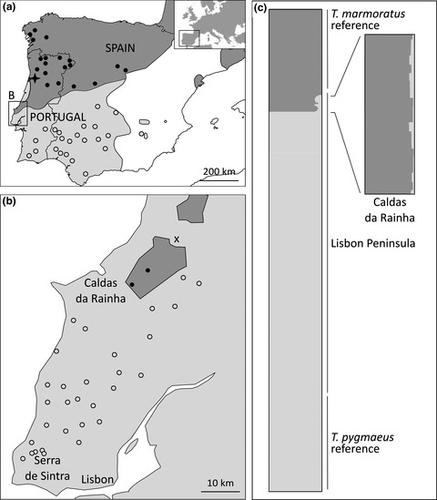当前位置:
X-MOL 学术
›
Ecol. Evol.
›
论文详情
Our official English website, www.x-mol.net, welcomes your
feedback! (Note: you will need to create a separate account there.)
Tracing species replacement in Iberian marbled newts
Ecology and Evolution ( IF 2.3 ) Pub Date : 2020-12-15 , DOI: 10.1002/ece3.7060 Julia López-Delgado 1, 2, 3 , Isolde van Riemsdijk 1, 4 , Jan W Arntzen 1
Ecology and Evolution ( IF 2.3 ) Pub Date : 2020-12-15 , DOI: 10.1002/ece3.7060 Julia López-Delgado 1, 2, 3 , Isolde van Riemsdijk 1, 4 , Jan W Arntzen 1
Affiliation

|
Secondary contact between closely related species can lead to the formation of hybrid zones, allowing for interspecific gene flow. Hybrid zone movement can take place if one of the species possesses a competitive advantage over the other, ultimately resulting in species replacement. Such hybrid zone displacement is predicted to leave a genomic footprint across the landscape in the form of asymmetric gene flow (or introgression) of selectively neutral alleles from the displaced to the advancing species. Hybrid zone movement has been suggested for marbled newts in the Iberian Peninsula, supported by asymmetric gene flow and a distribution relict (i.e., an enclave) of Triturus marmoratus in the range of T. pygmaeus. We developed a panel of nuclear and mitochondrial SNP markers to test for the presence of a T. marmoratus genomic footprint in the Lisbon peninsula, south of the enclave. We found no additional populations of T. marmoratus. Analysis with the software Structure showed no genetic traces of T. marmoratus in T. pygmaeus. A principal component analysis showed some variation within the local T. pygmaeus, but it is unclear if this represents introgression from T. marmoratus. The results may be explained by (a) species replacement without introgressive hybridization and (b) displacement with hybridization followed by the near‐complete erosion of the footprint by purifying selection. We predict that testing for a genomic footprint north of the reported enclave would confirm that species replacement in these marbled newts occurred with hybridization.
中文翻译:

追踪伊比利亚大理石蝾螈的物种更替
密切相关的物种之间的二次接触可以导致杂交区的形成,从而允许种间基因流动。如果一个物种比另一个物种拥有竞争优势,就会发生杂交区移动,最终导致物种更替。预计这种杂交区的置换将以选择性中性等位基因从置换物种到前进物种的不对称基因流(或基因渗入)的形式在整个景观中留下基因组足迹。在不对称基因流和T. pygmaeus范围内Triturus marmoratus的分布遗迹(即飞地)的支持下,伊比利亚半岛的大理石蝾螈出现了杂交区运动。我们开发了一组核和线粒体 SNP 标记,以测试飞地南部里斯本半岛是否存在斑鳀基因组足迹。我们没有发现额外的斑鳀种群。 Structure软件分析表明, T. pygmaeus中没有T. marmoratus的遗传痕迹。主成分分析显示当地T. pygmaeus内部存在一些变异,但尚不清楚这是否代表T. marmoratus的基因渗入。结果可以通过(a)不进行渐渗杂交的物种替换和(b)通过杂交进行置换,然后通过纯化选择对足迹进行近乎完全侵蚀来解释。我们预测,对报告的飞地以北的基因组足迹进行测试将证实这些大理石蝾螈的物种更替是通过杂交发生的。
更新日期:2021-01-08
中文翻译:

追踪伊比利亚大理石蝾螈的物种更替
密切相关的物种之间的二次接触可以导致杂交区的形成,从而允许种间基因流动。如果一个物种比另一个物种拥有竞争优势,就会发生杂交区移动,最终导致物种更替。预计这种杂交区的置换将以选择性中性等位基因从置换物种到前进物种的不对称基因流(或基因渗入)的形式在整个景观中留下基因组足迹。在不对称基因流和T. pygmaeus范围内Triturus marmoratus的分布遗迹(即飞地)的支持下,伊比利亚半岛的大理石蝾螈出现了杂交区运动。我们开发了一组核和线粒体 SNP 标记,以测试飞地南部里斯本半岛是否存在斑鳀基因组足迹。我们没有发现额外的斑鳀种群。 Structure软件分析表明, T. pygmaeus中没有T. marmoratus的遗传痕迹。主成分分析显示当地T. pygmaeus内部存在一些变异,但尚不清楚这是否代表T. marmoratus的基因渗入。结果可以通过(a)不进行渐渗杂交的物种替换和(b)通过杂交进行置换,然后通过纯化选择对足迹进行近乎完全侵蚀来解释。我们预测,对报告的飞地以北的基因组足迹进行测试将证实这些大理石蝾螈的物种更替是通过杂交发生的。









































 京公网安备 11010802027423号
京公网安备 11010802027423号